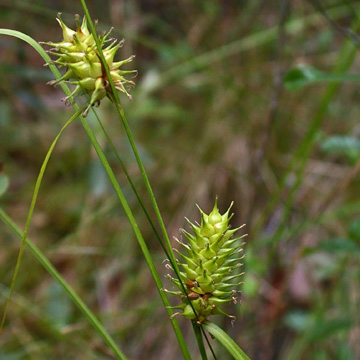

Carex bullata - (image 1 of 3)
Taxonomy
Family: Cyperaceae
Section Vesicariae
Habitat
Acid swamps and bogs, peaty or sandy shores.
Associates
Distribution
Mainly on the coastal plain from Nova Scotia to GA.
Morphology
Tufted perennial from long, stout, creeping rhizomes; stems slender, 30-90 cm, sharply trigonous and roughened distally; leaves 2-5 mm wide; staminate spikes 1-3 on a long common peduncle surpassing the uppermost pistillate spike; pistillate spikes 1-2, well separated, 1.5-4 cm long and 1.5-2 cm thick; perigynia ascending or spreading, green or stramineous, closely imbricate, broadly ovoid, 6-9 mm long and 2.5-3 mm wide, abruptly contracted to a stout, rough-margined beak 2.4-4.2(-4.8) mm long, with straight slender teeth 0.5-1.4 mm long; achenes brown, symmetrical, trigonous, smooth.
Notes
Fruiting June to August
Wetland indicator: OBL
Similar to C. utriculata but with pistillate spikes that are usually shorter in length and perigynia with longer beaks that are scabrous distally. Photographed in southern NJ.
References
Ball, P.W. and A.A. Reznicek. 2002. Carex, In: Flora of North America Editorial Committee, Eds. Flora of North America North of Mexico. Volume 23. Oxford University Press, New York.
Gleason, Henry A. and A. Cronquist. 1991. Manual of Vascular Plants of
Northeastern United States and Adjacent Canada. Second Ed.
The New York Botanical Garden. Bronx, NY
|
© Michael Hough 2018 |